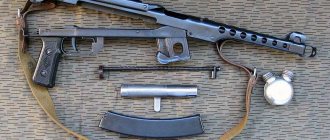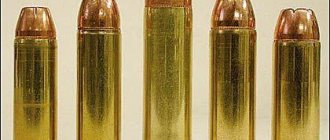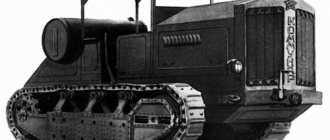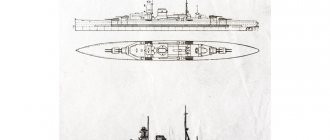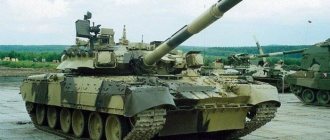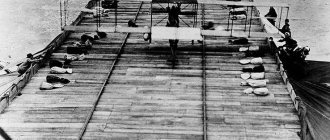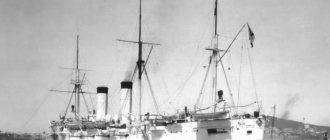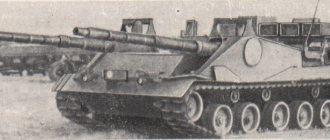Created in the early 60s, the ZIL-118 bus was based on the technical solutions included in the then newest ZIL-111 limousine. The car received a futuristic appearance with a panoramic windshield and additional transparent inserts in the roof slopes. The bus was received with interest by the world community, since there were no analogues to the car. During the 1967 bus week held in Nice, the car won 9 different prizes.
However, in the USSR the car faced a difficult and difficult fate. Over 30 years of production, only 87 buses were assembled. The machines were distributed to various government agencies. It is for this reason that many copies have survived to this day - a total of 60 ZIL-118 vehicles of all modifications have survived.
History of creation
The reason for the development of the ZIL-118 bus was an attempt by the Likhachev plant to ensure the profitability of the production of government limousines. The cost of cars increased sharply during the transition from the ZiS-110 to the ZiL-111, since at the same time the production of the GAZ-13 limousine began, which began to be used as an official car for the average party nomenclature.
In 1959, a technical specification appeared, according to which it was proposed to create a multi-seater car with a carriage layout on the ZIL-111 chassis. The bus was supposed to be used as a service vehicle and as an ambulance. The initiator of the idea was N.F. Grinchar, who served as production manager of the plant.
The first preliminary design was a 6-door car designed to seat 15 people.
The front and rear tail surfaces remained unchanged from the ZIL-111. This idea was quickly abandoned, reworking the project into a 5-door bus with a carriage layout. In 1960, a model of the machine was built, the design of which was worked on by E.V. Sabo.
The appearance of the resulting car did not suit the author, and the project underwent another design change. The third option was approved in the late autumn of 1960 under the designation ZiL-AB. At the beginning of next year, production of chassis and body elements began.
After production began, the project received the name ZIL-E118. The assembly of the first car was carried out with sheer enthusiasm with the support of the secretary of the Komsomol committee V.G. Mazepa. The bus was ready in 1962 and shown to N.S. Khrushchev, who really liked the car. Initial plans included the start of production of the ZIL-118 Yunost in the second half of 1963. However, the plan was not implemented.
In 1967, the ZIL-118 “Youth” was demonstrated at the international bus exhibition in Nice. Immediately after this, the light saw another order to begin serial production, which was scheduled for 1968. For five years, from 1963 to 1968, the plant refined the design of the machine. In particular, a climate control system with air conditioning was tested. The tests ended unsuccessfully due to insufficient performance of the fans and compressor.
In 1970, the ZIL-118 was shown to Henry Ford II, who was on a visit to the USSR. The car attracted the interest of an American entrepreneur, who even wanted to purchase a production license. However, the matter did not progress beyond conversations.
In the same 1970, work began on the creation of a modernized model, designated ZIL-118K. Initially, the project was named ZIL-119, which was abandoned in 1971.
The new version of the car received a modified body without a sunroof.
The seats and instrument panel have been changed in the cabin. The steering kinematics have changed somewhat. Units from the new ZIL-114 limousine began to be used in the design of the bus chassis. By the mid-70s, six ZIL-118Ks were built, which worked at the plant and were gradually improved.
In the early 90s, the third version of the vehicle was released under the designation ZIL-3207. The design used disc brakes and a three-speed transmission from the ZIL-4105 limousine. Due to the rearrangement of the cabin, the number of seats was reduced to 16.
In 1991-95, a record 30 vehicles of version 3207 were assembled for the plant. The worsening situation at the ZIL plant led to the cessation of bus production in the spring of 1995. Later, three more bodies were assembled, one of which was brought to the state of a finished car. The two remaining bodies were stored for a long time in a warehouse for semi-finished products.
As a passenger
Before leaving, I’ll sit in the passenger seat for a while and feel like a passenger. I don’t sit down, but plop down in a soft chair. The seat has a thick plush cushion that envelops you with an unusual anatomical design, like in a modern car, and elastic compliance.
The livery of this "Youth" No. 8 reproduces the example No. 6, which won prizes in 1967 at the 15th International Tourist Rally and the 18th International Bus Week in Nice.
source
Design
The body of the ZIL-118 is built according to a partially load-bearing design. The chassis was based on spars and cross members, forming a load-bearing frame. The spars were rectangular pipes connected to the cross members by welding. The power unit, gearbox and front suspension were mounted on a subframe, which was then attached to the lower part of the body.
This arrangement made it possible to remove the unit from the vehicle for repair and maintenance. The screw-nut steering is equipped with a hydraulic booster. Due to the forward steering column, it was necessary to install an angular gearbox and an additional driveshaft that connected the column shaft to the steering mechanism.
In the standard version, the cabin seats 17 passengers.
The ZIL-118 interior is equipped with a heating and ventilation system. Air conditioning was not installed. Access to the interior was through a swing door located in the right side of the body.
At the rear of the body there was an additional hinged door that provided access to a small luggage compartment located behind the backs of the rear row of seats. In the medical version of the bus, the door was used to load a stretcher with a patient.
The driver entered the workplace through an individual door located in the front part of the left side. Next to the driver was a huge casing that covered the engine. The automatic transmission selector was located directly on the top of the casing. The dimensions of the ZIL-118 engine did not allow placing a passenger seat next to the driver.
To access the power unit there was a cover located at the beginning of the passenger part of the cabin. A glass partition is installed between the driver's cabin and the passenger compartment. The bus body had external and internal lining, with a layer of polyurethane foam filler between them. At the first releases of the bus, there was a sliding hatch in the roof with dimensions of 1830 * 680 mm.
All produced ZIL-118 buses are equipped with a V-shaped 8-cylinder gasoline engine.
To prepare the working mixture, until 1970, a two-chamber K-88D carburetor was used, equipped with an accelerator pump and an economizer.
Later, the improved K-88AL began to be used. The engine of cars manufactured before 1990 has a power of 170 hp. with a working volume of 5.969 liters. The very first buses were equipped with an engine with a rev limiter, which developed a power of 150 hp.
The power unit is a slightly modified engine from the ZIL-130 truck. In 1968, an attempt was made to install a ZIL-136 diesel engine, which ended unsuccessfully. An attempt to install a smaller version of the engine under the designation ZIL-130M, which developed a power of 138 hp, also ended in failure.
The latest releases of ZIL-118 buses are equipped with a 180-horsepower engine with a volume increased to 6.962 liters. The increase in volume was achieved by using a cylinder block with a diameter increased by 8 mm. The engine is equipped with a K-95 carburetor. Another difference of the engine is the compression ratio increased to 7.3 units, which required the use of gasoline with an octane rating of 92/93.
The previous engine ran on A76 fuel. The fuel supply is located in two tanks located at the rear of the bus. The capacity of the tanks is 150 liters each; since 1977, the tanks have been increased by 10 liters, for a total of 320 liters per bus, which is pretty good. Power reserve over 1000 km.
On early cars, the filler necks were located under the folding rear lights.
A similar solution was widely used on American passenger cars. Since 1970, the necks have been placed on the sides of the body at the rear of the bus.
The transmission consists of a torque converter and a planetary gearbox. Early ZIL-118 buses are equipped with a four-wheel torque converter. Since 1970, a three-wheeled design has been used. The planetary gearbox has two forward gears - low and direct.
The box also has one reverse speed. The transmission allowed the bus to accelerate to a speed of 120 km/h.
Drum-type brake mechanisms, hydraulic drive. A vacuum booster is included in the brake circuit. The cabin had a double brake pedal, which made it possible to stop the bus with either foot. When parked, the bus was held in place by a mechanical drum brake acting on the transmission.
The front suspension of the ZIL-118 bus is borrowed from the executive class passenger car ZIL-111.
The suspension includes independent wishbones and coil springs. Additionally, telescopic shock absorbers and anti-roll bar are installed. The first buses used lever shock absorbers.
At the rear there is a stamped beam of the ZIL-111 bridge, made according to the “banjo” pattern. The bridge is mounted via leaf springs, complemented by telescopic shock absorbers. The main pair has hypoid gears, and the gearbox includes a differential.
The main technical characteristics of buses of the ZIL-118 family are given in the table.
| Parameter | ZIL-118 | ZIL-118K | ZIL-3207 |
| Base, mm | 3740 | ||
| Length, mm | 6860 | 6910 | n.d. |
| Width, mm | 2115 | ||
| Height, mm | 2088 | 2025 | 2035 |
| Dry weight, kg | 3200 | 3530 | 3950 |
| Maximum weight, kg | 4770 | 5100 | 5321 |
| Fuel consumption, l/100 km | 25-30 | ||
Early AMO buses[ | ]
The first AMO bus with a capacity of 14 passengers was created in 1926 on the chassis of a 1.5-ton AMO-F-15 truck. The body was made on a frame made of bent wooden profiles and sheathed in metal, the roof was covered with leatherette. There was only one passenger door - in front of the rear wheel arch. Four-cylinder carburetor engine with 35 hp. With. allowed the bus to accelerate to 50 km/h. In addition, since 1927, a two-door postal bus (the back door was behind the rear wheel arch) and an ambulance (without side doors) were produced. Third-party manufacturers also installed their own bodies on the AMO-F-15 chassis, for example, an open one with a canvas awning for servicing resorts. In addition, since 1927, 9 copies of staff cars with an open 8-seater passenger-type body have been produced directly at AMO. In total, on the AMO-F-15 chassis in 1926-1932. approximately several hundred buses were produced (no more than 150-200 units) with different body designs. In 1933, the AMO-4 bus appeared with the same body design as its predecessor. The vehicle, with a capacity of 22 passengers, was built on an extended AMO-4 chassis based on the AMO-3 truck, the immediate predecessor of the legendary ZIS-5. Maximum speed AMO-4 with a 6-cylinder engine with a power of 60 hp. With. was 55 km/h. A batch of several dozen cars was produced.
Modifications
Based on the ZIL-118 bus, there was only one modification - a resuscitation vehicle under the designation ZIL-118A. The external difference of the body was the central part of the roof, which could rise up, allowing members of the medical team to work while standing at full height. A total of three resuscitation buses were built, two of which worked in the Kremlin hospital. The third bus served the ZIL clinic until the second half of the 80s.
The ZIL-118A ambulance was equipped with equipment for resuscitation and blood transfusion. A supply of different blood types for transfusion was on board the car. For ventilation, a separate installation with a heating radiator and an air filter was used. The cabin had space for a medical team, which consisted of five people. Additionally, a refrigerator, washbasin and disinfection chamber were installed.
The plant intended to produce a simplified version of the ambulance under the designation ZIL-118S. The difference was an ordinary roof and the absence of resuscitation equipment. The project remained implemented only on paper.
At the end of the 60s, a mobile reporting television station called ARTS was built on the basis of one of the ZIL-118 buses.
A rotating ring with a Voskhod model television camera was installed on the roof of the car. The cabin contained various broadcasting and receiving equipment; the antennas were located in the rear of the body on the roof.
The design of the machine made it possible to broadcast while moving at speeds of up to 70 km/h. The machine was used by the Leningrad Television Center for many years. The bus has survived to this day and is located in the NAM museum in Vsevolzhsk.
Based on the ZIL-118K, the 118KV version was built by order of the KGB. The car's interior was divided into two compartments, separated by a bulkhead with a door. One housed equipment, the other passengers. In fact, in the passenger compartment there was one seat for the operator and a table. The roof was made of plastic and could be removed.
For transportation by air, the delivery package included supports that prevented the bus from swaying during the flight. The installation of the equipment was carried out by Zelenograd. The curb weight of the car was 5500 kg, which is why tires with increased air pressure were used. Four cars were built in 1976-77.
The vehicles were used as carriers of government special communications equipment “Orbit”. All four built buses have been preserved, the equipment from the vehicles has been dismantled.
The ZIL-118K bus served as the basis for the construction of two ambulances with the index 118KA, which were distinguished by an increased roof height above the medical compartment. The cars were ordered to serve patients at the Kremlin hospital, but were rejected by the customer due to the excessive height of the body. One of the ambulance buses was used at the Sklifosovsky hospital.
Another version of the “nurse” was the ZIL-118KS, built in triplicate.
Later, in 1990, four more cars were built. The unrealized ZIL-118KE project was an ambulance with a 180-horsepower ZIL-375 engine and front disc brakes.
By order of the State Department of Internal Affairs of Moscow, the ZiL-118KL forensic laboratory was built. The salon was divided into three sections, it had eight workplaces and an additional place for a dog handler with a dog. On the roof there was a platform for photographing the scene of the incident from above.
Pre-war ZIS buses[ | ]
ZIS-8 bus on a USSR postage stamp, 1974
Based on the ZIS-5, or rather its extended base from 3.81 to 4.42 m, the ZIS-11 chassis in 1934-1936. A 22-seater (total number of seats 29) bus ZIS-8 was produced. Six-cylinder in-line carburetor engine with a volume of 5.55 liters and a power of 73 hp. With. allowed the ZIS-8 with a total weight of 6.1 tons to accelerate to 60 km/h. Only 547 units were produced at ZIS. ZIS-8, but from the second half of 1936 the production of this model (despite the huge needs of the fast-growing cities of the USSR) was stopped due to the reconstruction of the plant and the transition to the more advanced ZIS-16 model. However, the production of the much-needed bus according to the ZIS drawings was continued by a number of car repair enterprises in the country, for example, it was produced in Moscow until 1940. In addition, even before the war, a number of automobile repair enterprises produced small batches of open excursion buses based on the ZIS-8. In the Moscow bus fleet, the ZIS-8 (due to post-war overhauls) lasted until the early 50s. Production of the more advanced ZIS-16 bus, which, in accordance with the then automotive fashion, had a streamlined body shape, but was still built on a wooden frame, began in 1938 and continued until August 1941 (according to some sources, until the end of the 1940s, the bus also assembled from stock of spare parts). The bus could accommodate up to 34 passengers (with 26 seats). Boosted to 84 hp. With. The ZIS-16 engine accelerated the vehicle with a total weight of 7.13 tons to 65 km/h. Since 1939, a limited series of the ZIS-16S ambulance bus was produced with a separate cabin from the ZIS-5, designed to transport 10 stretchers and 10 seated patients. A total of 3,250 ZIS-16 buses were produced (excluding post-war vehicles). Some of them, not mobilized into the Red Army in the initial period of the war, were equipped in 1943 with gas generator and gas cylinder installations, dismantled in 1945. Thanks to the modern and recognizable appearance of the ZIS-16, it became a very characteristic feature of the street landscape of Moscow in the late 30s and early 50s. A significant part of the ZIS-16 buses after the war was reconstructed at Aremkuz and other enterprises and replaced with new ZIS-150 chassis. Such radical measures allowed the ZIS-16 to be modified on suburban routes of the capital until the mid-50s, and in a number of cities even longer.
Bus ZIS-16 on a USSR postage stamp, 1975
Ergonomics
Review in the workplace - it couldn't be better! I sat down well, finding two adjustments for the driver's seat (this is quite a lot for a car that has reached its sixth decade) with a plump cushion and a short backrest without a headrest. I looked at the small round rear-view mirrors, mounted on separate chrome-plated “chicken legs”, and felt the light and thin steering wheel by today’s standards, in the hub of which there was a ruby car factory logo, like the Kremlin stars on the towers.
The main focus is on the pedal assembly, because there are four pedals, and this is with the automatic transmission alive and well. I list from left to right: the parking brake, the brake pedal forked on both sides of the steering column and the accelerator. The most important thing is that the driver does not have the desire to squeeze a non-existent clutch, otherwise the consequences of sudden braking without good reason are unpredictable.
In the 1960s, door upholstery around the world had minimum requirements: it should be uncluttered and hygienic.
I pull out the chrome-plated fungus of the carburetor air damper and with a few turns of the starter I start the slightly modified short-stroke (cylinder diameter 100 mm, piston stroke 95 mm) “130th” engine. After a few seconds, the large play of the steering mechanism eliminates itself, thanks to the powerful power steering pump, and the ears are caressed by the thick bass, confirmed by one and a half hundred “mares” and four hundred Newtonometers of torque, which is already achieved just above one and a half thousand revolutions per minute, although, according to sensations, in general almost from idle - the size of the engine displacement matters!
